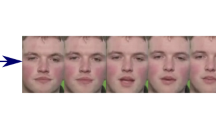Abstract
We present MikeTalk, a text-to-audiovisual speech synthesizer which converts input text into an audiovisual speech stream. MikeTalk is built using visemes, which are a small set of images spanning a large range of mouth shapes. The visemes are acquired from a recorded visual corpus of a human subject which is specifically designed to elicit one instantiation of each viseme. Using optical flow methods, correspondence from every viseme to every other viseme is computed automatically. By morphing along this correspondence, a smooth transition between viseme images may be generated. A complete visual utterance is constructed by concatenating viseme transitions. Finally, phoneme and timing information extracted from a text-to-speech synthesizer is exploited to determine which viseme transitions to use, and the rate at which the morphing process should occur. In this manner, we are able to synchronize the visual speech stream with the audio speech stream, and hence give the impression of a photorealistic talking face.
Similar content being viewed by others
References
Avidan, S., Evgeniou, T., Shashua, A., and Poggio, T. 1997. Image-based view synthesis by combining trilinear tensors and learning techniques. In VRST' 97 Proceedings, Lausanne, Switzerland, pp. 103–109.
Barron, J.L., Fleet, D.J., and Beauchemin, S.S. 1994. Performance of optical flowtechniques. International Journal of Computer Vision, 12(1):43–77.
Beier, T. and Neely, S. 1992. Feature-based image metamorphosis. In SIGGRAPH' 92 Proceedings, Chicago, IL, pp. 35–42.
Bergen, J.R. and Hingorani, R. 1990. Hierarchical motion-based frame rate conversion. Technical Report, David Sarnoff Research Center, Princeton, New Jersey.
Beymer, D., Shashua, A., and Poggio, T. 1993. Example based image analysis and synthesis. Technical Report 1431, MIT AI Lab.
Black, A. and Taylor, P. 1997. The Festival Speech Synthesis System. University of Edinburgh.
Bregler, C., Covell, M., and Slaney, M. 1997. Video rewrite: Driving visual speech with audio. In SIGGRAPH' 97 Proceedings, Los Angeles, CA.
Burt, P.J. and Adelson, E.H. 1983. The laplacian pyramid as a compact image code. IEEE Trans. on Communications, COM-31(4):532–540.
Chen, S.E. and Williams, L. 1993. View interpolation for image synthesis. In SIGGRAPH' 93 Proceedings, Anaheim, CA, pp. 279–288.
Cohen, M.M. and Massaro, D.W. 1993. Modeling coarticulation in synthetic visual speech. In N.M. Thalmann and D. Thalmann, (Eds.), Models and Techniques in Computer Animation, Springer-Verlag: Tokyo, pp. 139–156.
Cootes, T.F., Edwards, G.J., and Taylor, C.J. 1998. Active appearance models. In Proceedings of the European Conference on Computer Vision, Freiburg, Germany.
Cosatto, E. and Graf, H. 1998. Sample-based synthesis of photorealistic talking heads. In Proceedings of Computer Animation' 98, Philadelphia, Pennsylvania, pp. 103–110.
Ezzat, T. and Poggio, T. A morphable model for the human mouth. Technical Report, MIT AI Lab, forthcoming.
Fisher, C.G. 1968. Confusions among visually perceived consonants. Jour. Speech and Hearing Research, 11:796–804.
Guenter, B., Grimm, C., Wood, D., Malvar, H., and Pighin, F. 1998. Making faces. In SIGGRAPH' 98 Proceedings, Orlando, FL, pp. 55–66.
Horn, B.K.P. and Schunck, B.G. 1981. Determining optical flow. Artificial Intelligence, 17:185–203.
Jones, M. and Poggio, T. 1998. Multidimensional morphable models: A framework for representing and maching object classes. In Proceedings of the International Conference on Computer Vision, Bombay, India.
Lee, S.Y., Chwa, K.Y., Shin, S.Y., and Wolberg, G. 1992. Image metemorphosis using snakes and free-form deformations. In SIGGRAPH' 92 Proceedings, pp. 439–448.
Lee, Y., Terzopoulos, D., and Waters, K. 1995. Realistic modeling for facial animation. In SIGGRAPH' 95 Proceedings, Los Angeles, California, pp. 55–62.
LeGoff, B. and Benoit, C. 1996. A text-to-audiovisual-speech synthesizer for french. In Proceedings of the International Conference on Spoken Language Processing (ICSLP), Philadelphia, USA.
Lim, J. 1990. Two-Dimensional Signal and Image Processing. Prentice Hall: Englewood Cliffs, New Jersey.
Montgomery, A. and Jackson, P. 1983. Physical characteristics of the lips underlying vowel lipreading performance. Jour. Acoust. Soc. Am., 73(6):2134–2144.
Moulines, E. and Charpentier, F. 1990. Pitch-synchronous waveform processing techniques for text-to-speech synthesis using diphones. Speech Communication, 9:453–467.
Olive, J., Greenwood, A., and Coleman, J. 1993. Acoustics of American English Speech: A Dynamic Approach. Springer-Verlag: New York, USA.
Owens, E. and Blazek, B. 1985. Visemes observed by hearing-impaired and normal-hearing adult viewers. Jour. Speech and Hearing Research, 28:381–393.
Parke, F.I. 1974. A parametric model of human faces. Ph.D. Thesis, University of Utah.
Pearce, A., Wyvill, B., Wyvill, G., and Hill, D. 1986. Speech and expression: A computer solution to face animation. In Graphics Interface, Vancouver, pp. 136–140.
Pighin, F., Hecker, J., Lischinski, D., Szeliski, R., and Salesin, D. 1998. Synthesizing realistic facial expressions from photographs. In SIGGRAPH' 98 Proceedings, Orlando, FL.
Scott, K.C., Kagels, D.S., Watson, S.H., Rom, H., Wright, J.R., Lee, M., and Hussey, K.J. 1994. Synthesis of speaker facial movement to match selected speech sequences. In Proceedings of the Fifth Australian Conference on Speech Science and Technology, Vol. 2, pp. 620–625.
Seitz, S. and Dyer, C. 1996. View morphing. In SIGGRAPH' 96 Proceedings, pp. 21–30.
Waters, K. and Levergood, T. 1993. Decface: An automatic lipsynchronization algorithm for synthetic faces. Technical report, Digital Equipment Corporation CRL Report.
Watson, S.H., Wright, J.R., Scott, K.C., Kagels, D.S., Freda, D., and Hussey, K.J. 1997. An advanced morphing algorithm for interpolating phoneme images to simulate speech. Jet Propulsion Laboratory, California Institute of Technology.
Wolberg, G. 1990. Digital Image Warping. IEEE Computer Society Press: Los Alamitos, CA.
Author information
Authors and Affiliations
Rights and permissions
About this article
Cite this article
Ezzat, T., Poggio, T. Visual Speech Synthesis by Morphing Visemes. International Journal of Computer Vision 38, 45–57 (2000). https://doi.org/10.1023/A:1008166717597
Issue Date:
DOI: https://doi.org/10.1023/A:1008166717597




